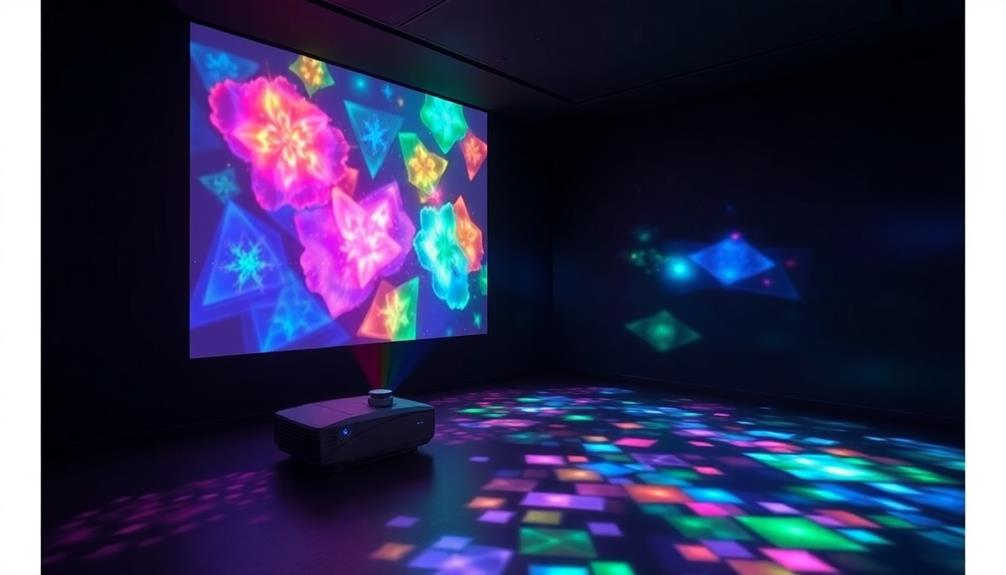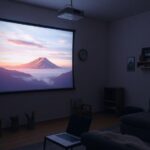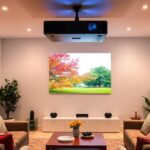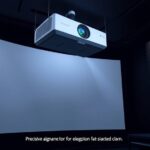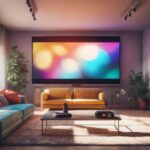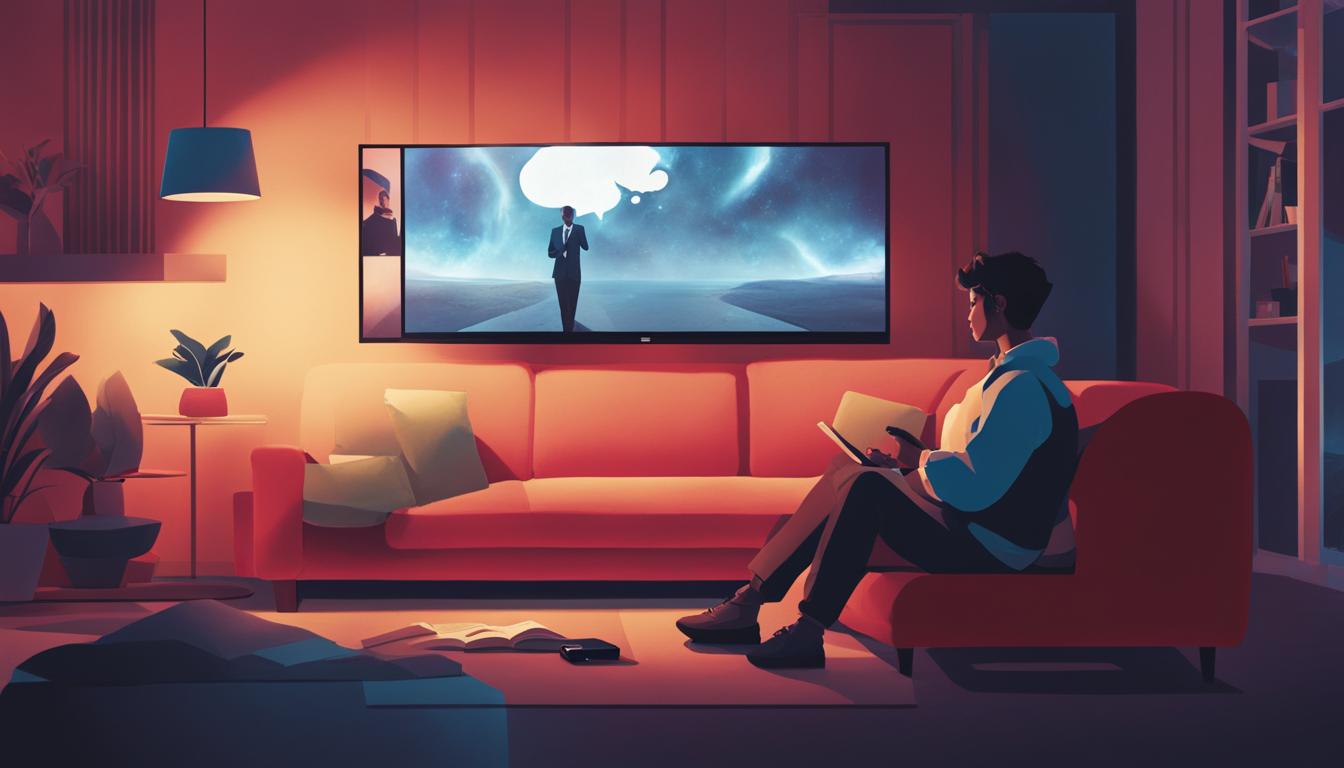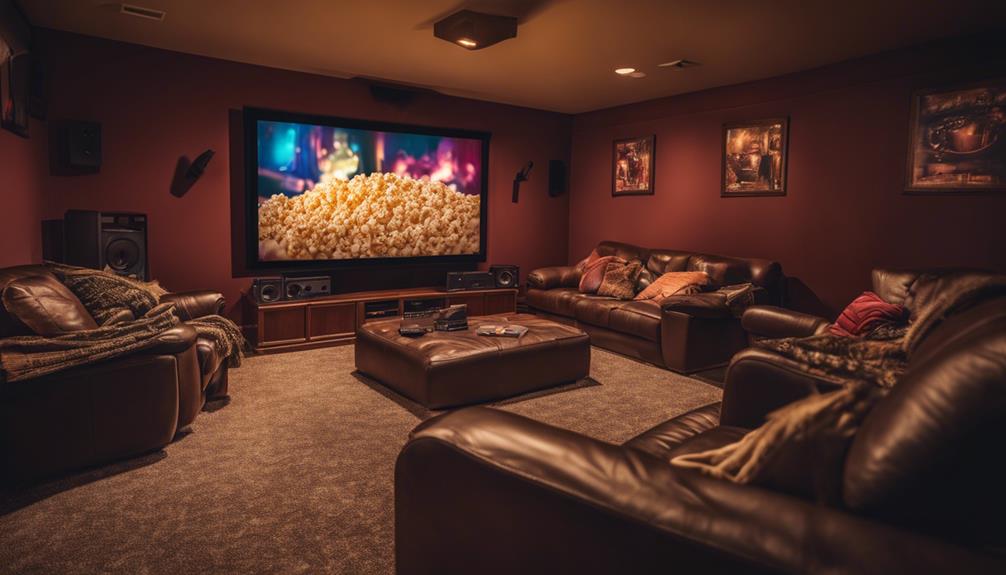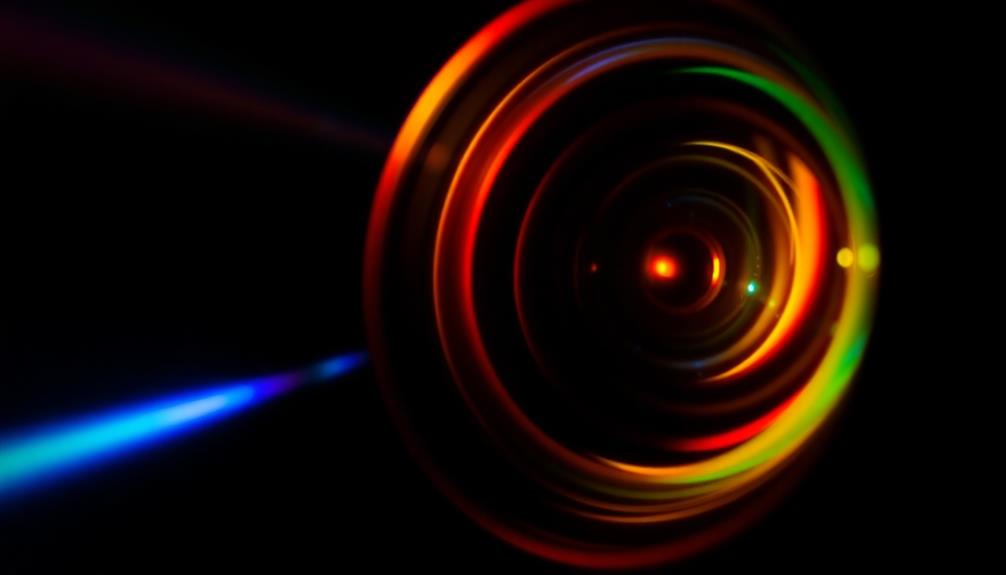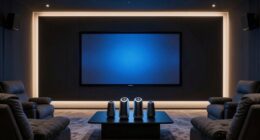You can create impressive hologram-like effects using a standard LCD projector and a few essential materials. Start by using a water-filled humidifier to generate steam, which serves as the projection medium. Position plastic drinking straws above the humidifier to enhance the visibility of your images. Aim your projector at the steam cloud and adjust angles for maximum clarity. For better results, consider using longer straws and a low-power fan to stabilize the steam. Don't forget that tweaking your setup can enhance brightness and detail, and there's so much more to explore to elevate your holographic presentations.
Key Takeaways
- Utilize a standard LCD projector aimed at a steam cloud generated by a humidifier for effective hologram-like projections.
- Position plastic drinking straws above the humidifier to enhance the visibility of projected images.
- Adjust angles and focus of the projector to improve clarity and brightness of the holographic effect.
- Consider using a 3D projector or multi-projector setup for enhanced dimensionality and depth in images.
- Incorporate AI and gesture control technologies for interactive and responsive holographic presentations.
Understanding Hologram Projections
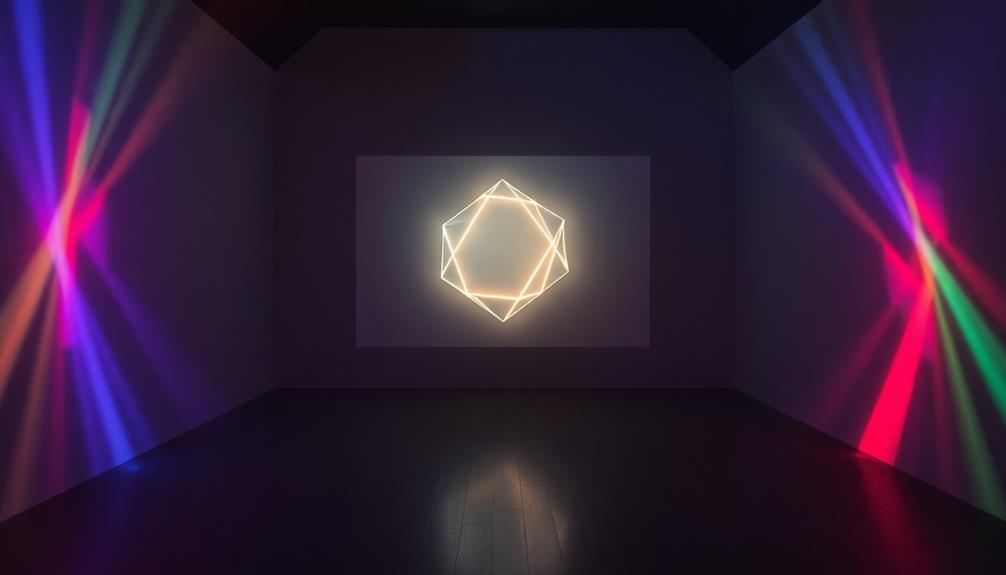
Understanding hologram projections begins with recognizing the fundamental components that make these enchanting visuals possible. You can generate holographic images using a standard LCD projector, but keep in mind that the resolution may be low and background interference can be a problem.
To create the desired effect, you'll need a water-filled humidifier to produce a steam cloud. This cloud acts as your projection medium, so positioning a bundle of plastic drinking straws above it's vital for ideal results.
Aim your projector directly at the steam cloud generated by the straws to see the holographic effects come to life. While you're at it, consider enhancing your setup with longer straws and a low-power fan. These additions can greatly improve the image quality and stability of the steam cloud.
However, don't forget that current limitations persist, including insufficient image clarity and a lack of dimensional movement in the holographic display. To truly elevate your projection game, you'll need to explore further refinements in your techniques.
Essential Equipment for Setup

To create stunning hologram-like effects, you'll need the right equipment and setup.
Start by gathering a standard LCD projector, plastic drinking straws, and a water-filled humidifier.
With the right materials and configuration, you're on your way to achieving mesmerizing projections.
Required Projector Specifications
Choosing the right projector is vital for creating impressive hologram-like effects. To get the best results, consider these specifications when selecting your projector:
- High Contrast Ratio: A projector like the LG PH150B offers a high contrast ratio, guaranteeing vivid colors and deep blacks.
- Lumens: Make certain your projector has sufficient lumens for visibility, especially in well-lit environments.
- Visible Light Transmission (VLT): Opt for a projector with at least 89% VLT to enhance the effects when using projection film.
- 3D Capability: While standard LCD projectors work, a 3D projector can markedly improve the dimensionality of your images.
Additionally, confirm you connect the projector to your PC using an HDMI cable. This connection is vital for displaying high-quality images and videos.
Finally, take care with the placement of your projector; aim the beam accurately at your projection surface to achieve peak brightness and clarity.
Materials and Tools Needed
When setting up hologram-like effects, you'll need several key materials and tools to guarantee everything runs smoothly.
First off, a standard LCD projector is essential. It confirms your projected images have adequate brightness and contrast, which is vital for creating effective holograms.
You'll also need a large quantity of plastic drinking straws. These will help create the steam cloud necessary for projecting the hologram. To generate that steam, a water-filled humidifier is required; it enhances the visibility of the images you project.
Proper placement is critical. Make sure your projector is aimed directly at the steam cloud, with the straws suspended above the humidifier. This positioning maximizes the effectiveness of your projection.
Additionally, consider using tripods for stability and an HDMI cable to connect your projector to your computer.
These tools will help you maintain a clean and organized setup, confirming everything functions well together.
With these materials and tools in hand, you'll be well on your way to creating impressive hologram-like effects that captivate your audience.
Setup Configuration Tips
With the right materials and tools gathered, configuring your setup becomes the next significant step.
You'll want to verify that each piece of equipment is properly positioned for ideal effects. Here are some essential setup configuration tips:
- Standard LCD Projector: This is vital for directing the image onto your display medium.
- Plastic Drinking Straws: Gather a large quantity to create the steam cloud necessary for projecting the holographic image.
- Water-Filled Humidifier: An important component for generating steam, enhancing the visibility of the projected image.
- HDMI Cable: Use this to connect your projector to a PC, allowing for seamless image projection and control.
When setting up, aim the projector directly at the rising steam cloud produced by the humidifier and straws.
This placement is key for achieving the hologram-like effect you're after. Make sure everything is aligned and adjust the focus as needed to create a clear image.
With these setup tips, you'll be well on your way to creating enchanting hologram-like effects that will impress your audience.
Step-by-Step Setup Guide
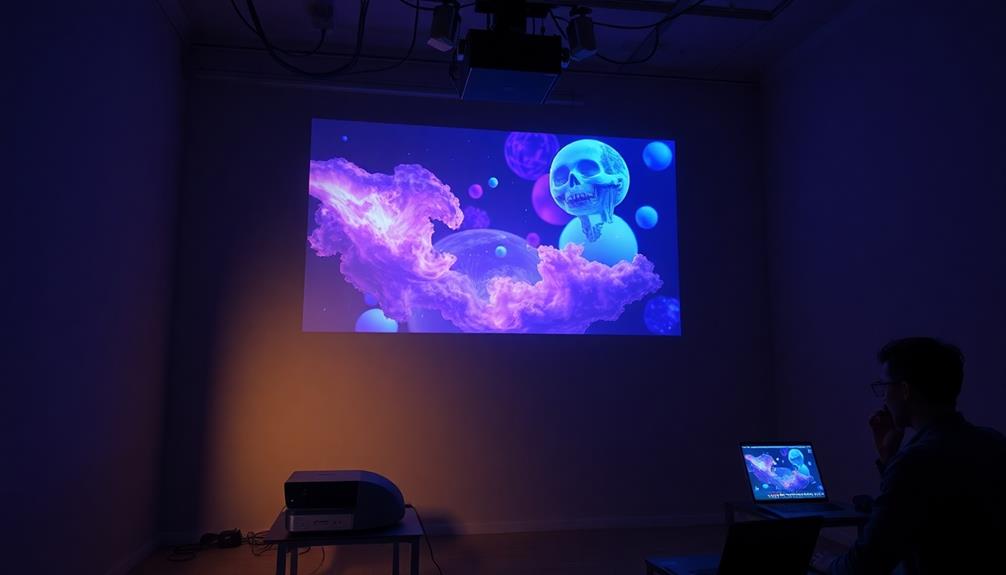
To create stunning hologram-like effects, start by setting up a water-filled humidifier that generates steam, which will act as the medium for your projection.
Place the humidifier on a stable surface, ensuring it's plugged in and filled with water. Next, position a bundle of plastic drinking straws directly above the humidifier vent, making sure they're suspended to prevent overheating during projection.
Now, grab a standard LCD projector and aim it at the steam cloud rising from the straws. Adjust the projector's position to find the ideal brightness and clarity. Don't hesitate to experiment with different angles to enhance the visibility of your projected image.
For even better results, you might want to take into account using longer straws, as they can help create a more extensive steam effect around the projection area.
If you have a low-power fan, use it carefully to stabilize the steam cloud, but be cautious of airflow that could disrupt your setup.
Once everything's in place, you're ready to enjoy your impressive hologram-like projections!
Enhancements for Better Effects

After setting up your projector and steam cloud, consider several enhancements that can elevate your hologram-like effects. Implementing these techniques can greatly improve the quality and immersion of your display.
- Lengthen your plastic drinking straws: Using longer straws can enhance the resolution and clarity of your projected hologram image.
- Incorporate a low-power fan: This can help stabilize the steam cloud produced by your humidifier, improving the overall visibility of the holographic effect.
- Switch to a 3D projector: A 3D projector can provide better dimensionality and depth compared to a standard LCD projector, resulting in more realistic images.
- Use two projectors: By displaying slightly varied images on two projectors, you can create a more dynamic and engaging holographic effect, enthralling your audience.
Additionally, don't forget to experiment with angles and projector placements. Continuous adjustments will help you achieve ideal brightness and clarity in your hologram.
Common Challenges Faced

What common challenges do creators encounter when trying to produce hologram-like effects? You'll quickly realize that achieving clarity in projected images is a major hurdle. Low resolution often leads to insufficient detail, making it tough to appreciate the intricacies of your hologram-like displays. Additionally, background visibility can muddle your projection, as unwanted images and light sources interfere with the intended effect.
Another issue is the static nature of the holographic image. Unlike true holography, the image doesn't change with viewer position, which limits the depth and dimensionality you likely want to showcase. Proper alignment and stabilization of your setup are vital; even slight misplacements can disrupt the effectiveness of your presentation.
To help you visualize these challenges, here's a quick overview:
| Challenge | Impact |
|---|---|
| Low Resolution | Insufficient detail |
| Background Interference | Detracts from the effect |
| Static Image | Limits depth perception |
| Misalignment and Instability | Disrupts overall presentation |
Continuous refinement and exploration of alternative methods are essential to overcome these challenges and enhance your hologram-like effects.
Exploring Future Technologies
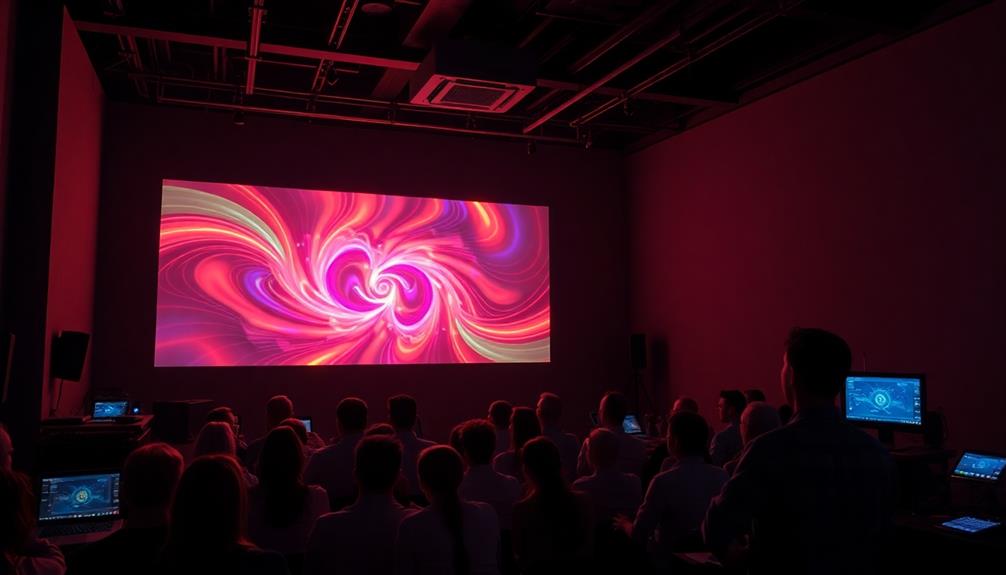
As you explore future technologies in holographic displays, you'll see exciting advancements that promise to make these tools more accessible and interactive.
Imagine integrating AI and computer vision to create environments that respond to your movements and commands.
Plus, using projective film on glass surfaces can enhance visibility while keeping that essential transparency intact.
Advancements in Holographic Displays
Holographic displays are on the brink of a revolution, driven by advancements in technology that promise to transform how we interact with visual content. The emergence of transparent OLED and LCD screens is a game-changer, although their high costs and performance limitations currently hinder widespread adoption.
Research into projection films has also shown potential, enhancing image visibility on glass surfaces, but it does come with some loss of transparency.
As you explore the future of holography, consider these exciting advancements:
- AI Integration: Future holograms may incorporate AI, making them more dynamic and responsive.
- 3D Projectors: Enhanced dimensionality in projections can create more immersive experiences.
- Multi-Projector Setups: Using multiple projectors could greatly improve the quality of holograms.
- High-Quality Projectors: Devices like the LG PH150B, with its high contrast ratio, can produce vibrant effects when paired with projection films.
These developments signal a bright future for holographic displays, pushing the boundaries of visual interaction.
As technology progresses, you'll likely find these innovations reshaping your perception of reality and creativity in the digital domain.
Interactive Transparent Technologies
The evolution of interactive transparent technologies is reshaping how we engage with visual content, taking inspiration from advancements in holographic displays.
You'll find that current developments focus on transparent OLED and LCD screens, although OLEDs can be pricey and LCDs often struggle with high reflectance. Fortunately, projective film is emerging as a more affordable alternative, allowing images to be projected onto glass with a degree of transparency that enhances visual experiences.
Looking ahead, future iterations of these technologies will harness AI for facial recognition, enabling real-time control of 3D models. This means you could interact with holographic images in ways that were once purely sci-fi.
Plus, the exploration of Leap motion technology for hand detection could revolutionize how you manipulate these images. Imagine using gestures to engage with holograms, making your experience even more immersive.
As these technologies evolve, the potential for dynamic user engagement will only grow. You'll be able to immerse yourself in interactive environments that blend the digital and physical worlds seamlessly, pushing the boundaries of what we've come to expect from visual content.
AI Integration Possibilities
Imagine stepping into a room where your gestures bring virtual objects to life, thanks to the seamless integration of AI with hologram technology. This fusion not only enhances your interaction with holographic displays but also transforms how you experience digital content.
With AI, future systems can adapt in real-time, creating a dynamic environment tailored just for you. As seen in recent advancements like Apple's AI privacy efforts, the potential for personalized experiences is becoming a reality across various technologies.
Here are some exciting possibilities:
- Real-time facial recognition: AI can track and recognize you, allowing personalized interactions with holograms.
- Optimized projection settings: Algorithms adjust for lighting and space, ensuring crystal-clear images every time.
- Behavioral adaptability: Machine learning enables the system to modify content based on your preferences and actions.
- Gesture manipulation: AI-driven control lets you use natural movements to interact with and manipulate 3D holographic images.
The potential of AI integration is immense. By facilitating object detection and pose estimation, holograms could seamlessly interact with both their environment and you.
This technology isn't just about visuals; it's about creating immersive experiences that feel intuitive and engaging. Prepare for a future where every gesture can spark a new reality.
Engaging Interactive Elements
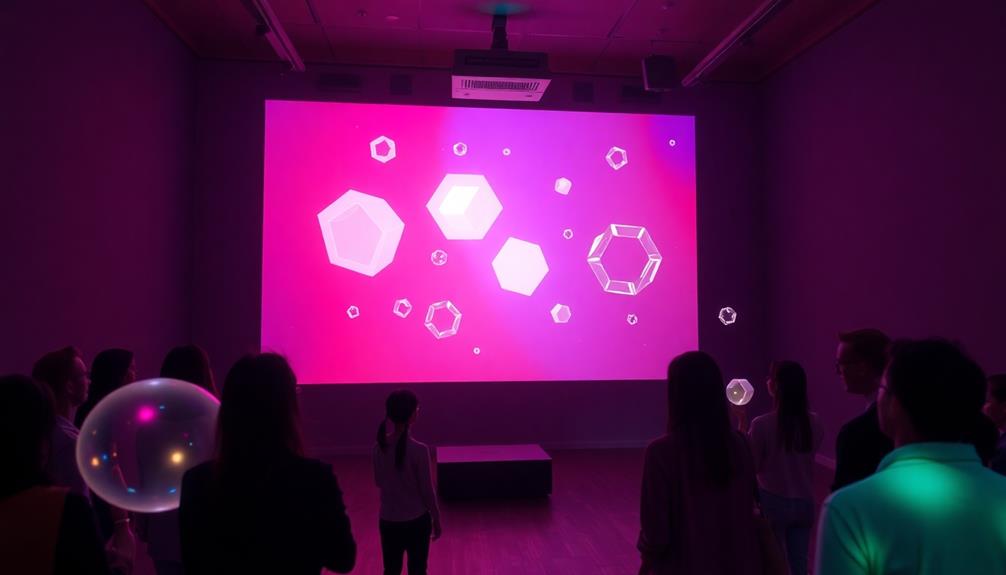
Engaging interactive elements transform the viewer's experience, making it more dynamic and immersive. By incorporating technologies like AI face detection, you can enable real-time control of 3D holographic models, enhancing your interaction with the display. Leap motion technology further elevates this experience, allowing you to use hand gestures for real-time manipulation of holograms.
The integration of object detection capabilities will lead to a more responsive and engaging holographic environment. Imagine watching demo videos that react to your movements—this kind of interaction makes the experience unforgettable.
Future advancements may explore pose estimation, enabling you to control holograms through body movements, effectively blurring the lines between the digital and physical worlds.
Here's a quick overview of the interactive elements you might consider:
| Technology | Interaction Type | Benefits |
|---|---|---|
| AI Face Detection | Dynamic Model Control | Enhanced interactivity |
| Leap Motion | Hand Gesture Control | Real-time manipulation |
| Object Detection | Responsive Content | Immersive experiences |
| Demo Videos | Movement Response | Engaging viewer interaction |
| Pose Estimation | Body Movement Control | Seamless digital-physical bridge |
These innovations will greatly enrich your holographic presentations.
Frequently Asked Questions
Can You Use a Projector to Make a Hologram?
Yes, you can use a projector to create hologram-like effects. By projecting images onto a medium like steam, you enhance the illusion. Experimenting with different setups can improve clarity and overall visual experience.
How Do You Make a Hologram Effect?
To create a hologram effect, you'll need to project images onto a misty canvas. Experiment with different setups, like using straws to enhance visibility and adding fans for stability, ensuring your display stays intriguing and clear.
What Is an Interactive Hologram?
An interactive hologram lets you engage with projected images through gestures or movements. By using sensors and AI, it responds to your actions, creating a personalized and immersive experience that transforms how you interact with digital content.
What Is the Holographic Projection Technique?
The holographic projection technique uses an LCD projector to cast images onto a steam cloud. You'll need proper placement and materials, like straws, to create a visually appealing effect, despite some limitations.
Conclusion
In summary, creating hologram-like effects with projectors and screens can transform your visual presentations into enthralling experiences. With the right equipment and setup, you can make your ideas come to life in ways people won't forget. So, why not experiment with these techniques and elevate your next project? As technology continues to evolve, the possibilities for interactive and immersive displays are endless. Immerse yourself and see how you can amaze your audience!
